
Location: Bridport, TAS
Established: 2004
Architect: Tom Doak & Michael Clayton
First Played: 27th Nov 2011
Last Played: 22nd Feb 2022
Magazine Ratings

4 (Current)

3 (Current)

2 (Current)
This course visit was based on my first time going to Barnbougle back in 2011, aiming to play the Australian Top 100. Ten years later I have returned four times, really taking in how good all courses on the property are. I have updated this article in places to reflect my thoughts now, or more recent photos.
2011 – Barnbougle Dunes and Lost Farm was on top of the list for the next golf trip due to the fantastic reviews I was constantly hearing about how good the designs were. If I was going to Tasmania I would play all the top 100 courses in one swoop, so Tasmania Golf Club and Royal Hobart Golf Club were lined up and I made an adventure out of it.

Sailing from the mainland for my week of golf
My wife was working doing a road trip so we went down by ship on the Spirit of Tasmania. Glad I have done it once but can’t say I would be in a hurry again, it wasn’t all that cheap and takes a bit longer.


Departing Spirit of Tasmania and on the way
Leaving the ship in Devonport we had a couple of hours drive to Bridport. Deciding to stay at the Lost Farm Resort. If you are travelling with the other half, I’ve been informed that they are one of the best day spas in Australia (my wife has done quite a few spas whilst I am out playing.

Entrance to Barnbougle Dunes
Barnbougle Dunes was once potato farming land, which Greg Ramsey and Richard Sattler dreamed big in developing a golf course which everyone would travel to. Built along the rolling sand dunes, the course overlooks Bass Strait. This is the Pacific equivalent of Bandon Dunes in Oregon USA, which now has four courses. Currently Barnbougle Dunes has two courses with talk of another being built in the near future.

The clubhouse at Barnbougle Dunes
Barnbougle Dunes was designed by Tom Doak and Michael Clayton, a combination who make design great courses together. If you cannot make it to Barnbougle Dunes, on the mainland of Australia you can go to St Andrews Beach in the Mornington Peninsula, which I would say to a degree has similar design concepts.

Inside the clubhouse of the Dunes course
One of the criteria when building the clubhouse, was to ensure it would be functional as a house if the course were to fail. Luckily that has not happened, with Barnbougle becoming an international destination for golfers. It is quite cosy to sit in here, especially if the weather has not been too favourable.

Barnbougle Dunes accommodation options
There is the option to stay at Barnbougle Dunes in the villas located on the course. Great way to get stuck straight into the golf. We had chosen Lost Farm Resort which is more like hotel accommodation, plus having a first class restaurant and the day spa.
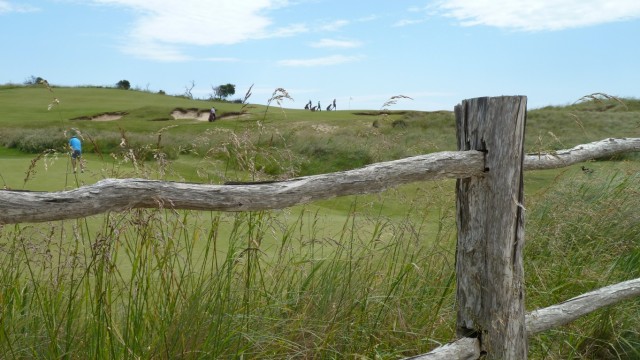
A quick warm-up on the practice green before the fun begins
One thing to do before starting is absorbing the scenery and setup of the course. It has a rustic feel. Can see the roots of this being farming land.

Course map of Barnbougle Dunes

Barnbougle Dunes Boobyalla scorecard

Hole 1 – 476 meter par 5
Starting the round is the longest hole on the course. This par 5 turns slightly to the right. The tee shot is between two large dunes, with the one on the right partially blocking the fairway. Plenty of fairway to hit, getting the confidence up with the first shot.

Looking back from the 1st green
As we get nearer the hole, the fairway narrows. A couple of bunkers are found in the middle of the fairway short of the green, with another to the right of the putting surface. This green has some big contours, as will most on the course, but the speed is suitable for the shapes. I would hate to think of Royal Melbourne green speeds on this course.

The airstrip along the 2nd – well how it was back in 2011, now located near Lost Farm
Feeling a bit luxurious, why not charter a plane and land directly at the course, rather than the hour long drive from Launceston. Makes for a quick trip in and out.
Update – With golf on King Island taking off in 2016, there is the option of flying to King Island and Barnbougle from Melbourne, taking in some of the best golf courses in Australia.

Hole 2 – 352 par 4
Probably one of the least interesting holes to look at on the course, this mid length par 4 is fairly flat. Being beside the airstrip would be a requirement for that I guess. The fairway is quite wide but a slight carry over rough to reach the short grass must be made. A bunker complex encroaches on around one third of the fairway at the driving length. There is also room to the right off the tee but will leave a harder shot to the green.

Undulating 2nd green
Green number two plays slightly up a slope, sitting next to heavy grass on the right. Large mounds and swales surround this area leaving a tricky shot if short of the green. One of the great things about Barnbougle is that you can play a variety of shots to get the same outcome. Sometimes hitting away from a hole to get it close must be done. It is all in your imagination on how to get the ball to the hole.

Hole 3 – 306 par 4
This short par 4 has some risks, mainly in how far you try to advance the ball down the fairway. An intimidating tee shot over scrub and dunes, most of the fairway is unsighted. The further right you hit the more distance gained, until it is too much and in the scrub. It is possible to drive through the fairway as well if you are too conservative. Dunes narrow in on the fairway the closer we get to the hole.

The third green
Green three has one small bunker to the left and a larger bunker in the dune to the right. This green predominantly slopes away from the front.

Hole 4 – 254 meter par 4
Great short par 4 offering a big reward, with a hell of a risk. Playing from a slightly raised tee, the fairway angles to the left but gently inclines, until it reaches the massive fairway bunker. At this point the fairway goes right up to the green.

A fairway bunker to avoid
Driveable from the tee the big risk is avoiding the cavernous bunker or scrub on the large dune. Plenty of fairway is available center to the right for those deciding to lay up, leaving a blind approach shot.

The funneling 4th green
The green on the 4th stands out, as both sides feed down into the middle. When the pin is in the middle this green plays a lot easier, but you are still not guaranteed to put the ball close.


Reg’s hut and the beginning of Barnbougle
After leaving the 4th green we come across Reg’s Hut. Can’t find anything on the history of this hut, but inside there is a story on the beginnings of Barnbougle, which is interesting and worth the read.

Coastal walk to the 5th tee
The walk between the fourth green and the fifth tee, takes in a stroll along the coast. Enjoy the scenery.

Hole 5 – 189 meter par 3
After the walk along the coast we come to the first par 3 on the course. This long par three, is actually shorter playing from an elevated tee. The green is hidden behind a large dune, which I would dread landing in. There is area out to the left for those not confident to play directly at the green.

The undulating 5th green
This green slopes from the right to the left, but also has a ridge through the middle. The rear surrounds slope back into the putting surface, assisting anything slightly long off the tee.

Hole 6 – 359 meter par 4
Playing from an elevated tee this hole looks like it runs through a canyon. Decision from the tee is which line to take. The right can lead to the approach being blind from behind a dune. Left takes on a dune to have a clear shot at the green. It was amazing walking up to the fairway along the path. It felt like walking into a valley fit for the kings.

Elevated 6th green
The approach to the sixth green is up a small slope. There are no bunkers at all around this green, but the putting surface slopes from the rear.

Hole 7 – 98 meter par 3
The shortest hole on the course, this par 3 is like playing a shot and landing it on a postage stamp. With the wind blowing this is extremely difficult to land on. To the left are two deep bunkers covering the length of the green. To the right the green surrounds slope away.

Evolution of the 7th green over the years. This course is a living, breathing thing, open to the elements, which can be harsh due to being near the coastal line. We start seeing erosion of the surrounding bunkers. The above shot was from 2018.

This was a shot taken from my last visit in early 2021. I plan to show a shot from each visit to see how this hole changes.
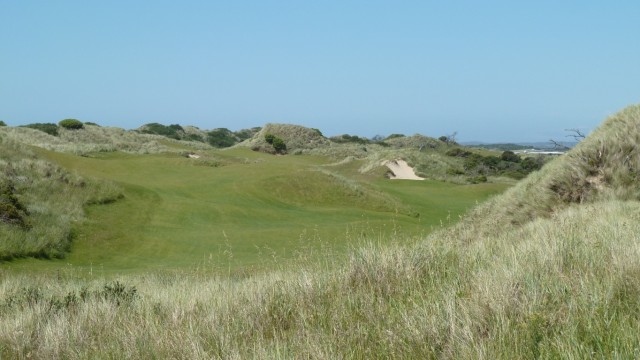
Hole 8 – 417 meter par 4
Another classic hole which I had read about before coming. The hardest hole on the course as well as the longest par 4, the tee shot is from an elevated position. You have a choice as this fairway is split. You can take the high road, which is a narrower fairway, is the shorter route and leave the approach from the same height as the green.

Split 8th fairway
The lower fairway has more room to play the tee shot, but increases the length to the hole. The approach will then be to a raised green. Large bunkers protect the hill in front of the green.

The oval 8th green
This green is located on a raised position compared to the fairway. A large dune and bunker are located to the left. The putting surface slopes away from the middle of the green to the front and rear. Par hear deserves bragging rights.

Hole 9 – 350 meter par 4
Making our way back to the clubhouse, this mid length par 4 plays over a small gully to the fairway. Reaching the rise on the fairway gives a clear view of the green. The approach will be made slightly down hill.

Clubhouse behind the 9th green
The ninth green has bunkers protecting the front and right sides. The putting surface slopes away from the front and has some slight undulations.
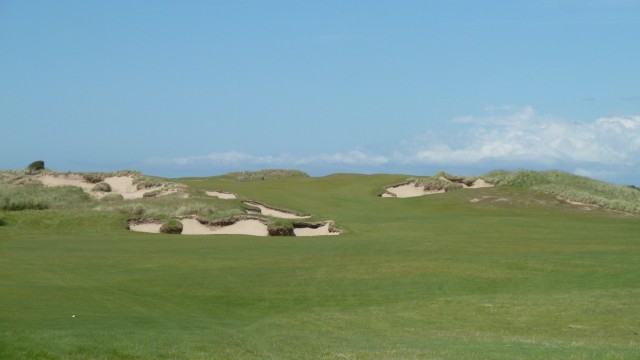
Hole 10 – 367 meter par 4
After a quick break we hit the back nine. The tenth is an extremely wide fairway, with the ideal line being close to the fairway bunker complex. The further right you play, the longer the approach shot, which is also up a large hill with further bunkers on either side of the green.

Large and undulating 10th green
A large green with a false front, has big undulations. Playing to the correct portion of the green is important here.

Hole 11 – 467 meter par 5
Playing over long grass to reach the fairway, this is also a blind tee shot to a hill which falls away. This wide fairway has bunkers at various points along the way to the green. The fairway has various slopes and undulations, but also slopes away to the right side.

The 11th green
A green with a small mound to the left and further sunken bunkers to the right, the green has quite a bit of space for any miss to the green.

Hole 12 – 238 meter par 4
This is the shortest par 4 on the course, another risk reward hole. Playing across a valley, the fairway is raised and runs at an angle to the right. From the right side of the fairway the ground slopes down into heavy grass. Again this has plenty of fairway for those taking the safe option, but those taking on the green face the big risk.

The scenic 12th green
Approaching the green, there are two small swales, but basically there is nothing to stop the ball being run into the green. There is a bunker at the rear, but more importantly step slopes away for anything too long. This is one of the high points of the back nine, giving a great view of the Tasman and the surrounding holes.

Hole 13 – 167 meter par 3
A great par three which plays down hill to the biggest green on the course. The green is surrounded by long grass or bunkers.
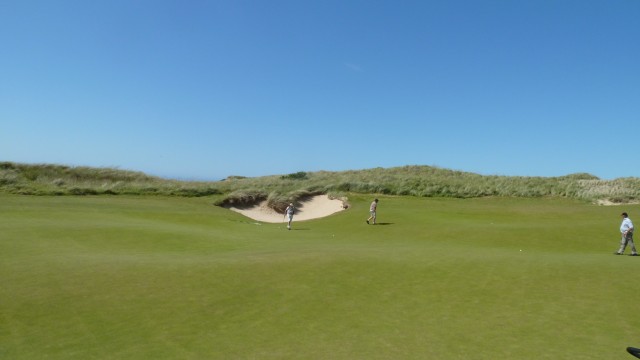
Largest green on the course is the 13th
It is not until you stand on this green that you realise how big it is. Covered with various undulations and slopes, I would dread to think the pin being at one end with my ball at the other. Don’t think it could be hit hard enough. Quite memorable.
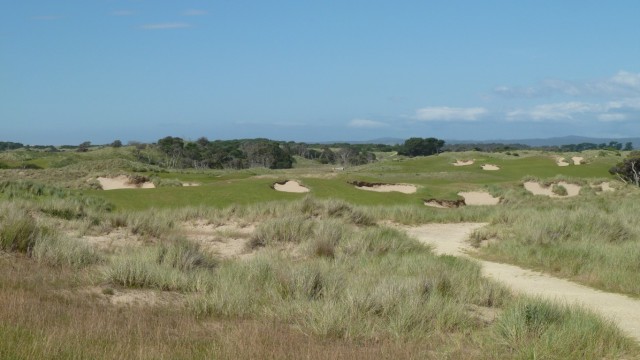
Hole 14 – 471 meter par 5
A tee shot over sandy waste to reach the fairway, peppered with bunkers for the landing area. The fairway angles to the right, giving the option to attack the fairway, but requires you to carry more bunkers to reach.

Oasis by the 14th
Beside the fourteenth fairway was this little water area, which reminded me of an oasis, as it was quite different to most of the course which had already been covered.

The furthest point of the Dunes course is the 14th Green
At about 150 meters out from the hole, the fairway turns left slightly left and rises up a gentle slope. The green has a small dune and two bunkers to the right and two further traps to the left. Sloping predominantly from the rear, the putting surface has gentle contours.

Hole 15 – 293 meter par 4
This hole runs along the river which separates the Dunes and Lost Farm courses. Another small par four which offers risk vs reward.

The fairway has a wide open fairway out to the left. Don’t go to far in this direction though, the green is located to the right of the bunkers, with a narrow strip of fairway leading to the green.

15th Green sits on top of the hill
The shelf leading to the green is narrow with heavy grass to the right and slopes to the left. The green is longer than it is wide, protected by bunkers on the right side.

Hole 16 – 147 meter par 3
Playing the easiest hole on the course, before we get the hard stretch home, we have a mid length par three which plays down hill. A large bunker to the left is short of the green, but the back of this is a large slope down to the putting surface.

Steep sloping 16th green
The green slopes away from the tee, quite steeply at that. With a few undulations this can be the easiest hole or can become quite difficult.

Hole 17 – 326 meter par 4
What I would say is the most intimidating tee shot on the course, you must carry a fair bit of heavy grass to reach the fairway. Note I was playing into a strong headwind making this worse. Most of the fairway is hidden from the tee, but it isn’t the widest landing area on the course. To the right is heavy scrub or even the beach, while left is more marram grass. A large mound of rough is found in the middle of the fairway.

Long but slightly undulating 17th Green
Making the approach shot to the green, you face a large bunker in a dune to the right, which is the main thing to avoid. There is a bit of room around this slightly raised green, which has many small undulations.

Hole 18 – 365 meter par 4
Second hardest hole on the course brings us home. A mid length par four has a carry to the fairway over heavy grass, to a fairly wide landing area. This is a slightly blind tee shot to a fairway which has an acute angle to the teeing box. You have the option of taking on the angle over the fescue, shortening the hole, or play safe to the large fairway. It is possible to drive through though for bigger hitters. The fairway starts to slope away towards the hole at about the half way point.

Last green for the day
The last green has a large swale in front, with the main danger being anything long, a large dune with heavy grass and bunkers await. The green has undulations running across the front and a large mound at the rear of the putting surface. Sink the putt, look back to enjoy the view, then sink a drink or too on the 19th.
Looking at the course makeup:
- Hole Directions – There was a reasonable variety allowing for conditions to have wide ranging effects during play. Around fifty five percent were westerly in direction, compared to forty five percent easterly facing. The biggest criticism would be the consecutive holes playing in the same direction. The first four holes play in a westerly direction away from the clubhouse. From here all bar two holes play in a easterly direction, until reaching 15, where play comes back towards the clubhouse in the opposite direction. With a westerly wind, this is not so bad, but from the east, it becomes a very hard slog. Admittedly there is not really much option to change this, taking into consideration some of the great links courses also have similar issues. But it is worth noting when comparing to the sister course Lost Farm
- Hole Lengths – Par three holes had a good variance in distance, the majority in mid length. Par four holes ranged from short to long with the majority being either short or mid length. Par 5 holes ranged from mid length to long with the latter being the majority. There was a good balance in distances, between the front and back nine
- Hole Layout – There was quite a strong imbalance in how the holes played. An overwhelming majority tended to favour turns to the right, where two shots or more were required to reach the green. This outnumbered those turning to the left three to one, with one hole playing reasonably straight. Over each nine the proportion in numbers were quite even. A majority of the holes used differing techniques in design and length, so it didn’t quite feel like you were playing the same hole over and over. One may be a true dogleg, whilst the next would require a tee shot with the fairway running at an angle
The course conditions were extremely good, from tee through to green. On my last visit we played a morning and afternoon round, finding there was a noticeable difference in how the greens played. Unusually they became much faster in the afternoon, with the wind drying out the grass. There was no apparent moisture in the morning, so it did seem quite unusual. Tees have been positioned very well, offering the beginner player the opportunity to avoid carries allowing for a fun game, where as the back markers offered greater challenges, offering risk and reward. Most fairways were very generous, allowing for a variety in play and different angles of approach. Bunkers are very strategic on the course, with great thought being given on placement. They blend in with the surroundings dunes. Oddly there was no waste areas throughout the course, something which would have been very natural within the areas. Lastly the green complexes throughout the course have been excellently designed. From small gently sloped surfaces, such as the 7th, to large undulating greens such as the 13th (one of the more controversial). Along with this a majority has shorter grass on the surrounding areas, leading to a multitude of decisions to be made by the player on how to get the ball in the hole. Chipping, bump and run or even putting are options to be explored.
There were quite a few memorable or standout holes. In particular my favourites were 3, 4, 6, 7, 12, 13, 15 and 17.
In summary, what else can be said, other than a fantastic course. It took a lot of courage to build this complex basically in the middle of no where. I believe the rewards are now being reaped and this will become a complex with three to four courses in time (as of 2021 a new short 14 hole course, Bougle Run is about to open). This is pure golf. Good routing through the dunes, great use of the land, giving a pure links feel. This feels a natural course where nothing feels out of place or artificial. Having short grass around the undulating greens, makes you think about the best way to get the ball to the hole. There are many ways to do this and none are incorrect, except flopping every shot, the greens won’t do you any favours.
So the big question is, what course do I prefer out of the two at Barnbougle. This would probably be Lost Farm. The collection of holes at Barnbougle are probably superior, but it is the directional routing which I have problems. Having played this course in a variety of winds, when it is into an easterly, the journey gets a little tiring.
How to play Barnbougle Dunes:
This is a public access course available seven days a week. Ring the Barnbougle Dunes pro shop to book a tee time.

